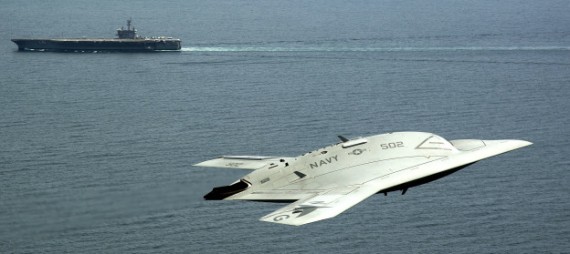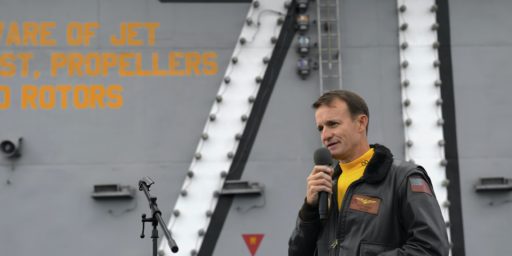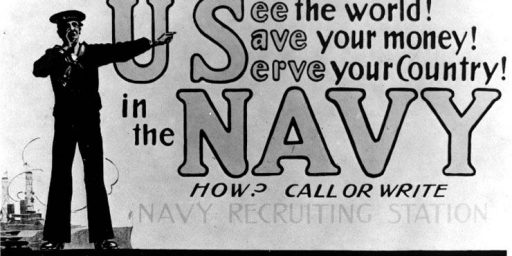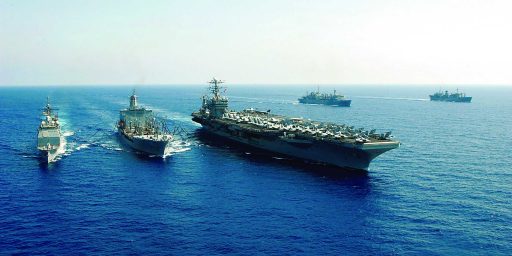Navy Building Carrier Drone
The Navy is building a ridiculously expensive robot spy plane.
The Navy is building a ridiculously expensive robot spy plane.
USNI News (“Navy Docs Reveal UCLASS Minimum Ranges and Maximum Costs“):
The Navy aims to build a stealthy pilotless aircraft to patrol at a minimum range of 600 nautical miles around an aircraft carrier at a maximum cost of $150 million a copy, according to a May Navy requirements documents obtained by USNI News.
The Unmanned Carrier Launched Airborne Surveillance and Strike (UCLASS) so-called key performance perimeters (KKPs) outline an aircraft that will primarily fill information, reconnaissance, surveillance and targeting (ISRT) roles for the service’s carrier strike group with a limited ability to strike targets at a range of 2,000 nautical miles from the strike group in lightly contested environments, according to the documents.
[…]
The KPPs call for an aircraft that can field a 3,000 pounds worth of payload, including a 1,000 pounds of air-to-surface weapons — including the 500 pound Joint Direct Attack Munitions and Small Diameter Bomb II.
To compare, the F/A-18E/F Super Hornet — the current manned carrier strike fighter — can carry almost 18,000 pounds of ordinance and external fuel.
[…]
Put into perspective, a single F/A-18E/F Super Hornet has a recurring flyaway cost of $66.9 million an aircraft, according to 2012 Navy budget documents.
[…]
“You normally have a 12 hour fly day with a 12 hour gap in airborne surveillance in the strike group,” Corgnati said. ”You can launch UCLASS at the end of your fly day and it can span that gap while your flight deck is shut down.”
The ISR role is one that would seem especially well suited to remotely piloted vehicles. The work is incredibly tedious and the hours long. Those flying UCLASS remotely can work in shifts in a way that pilots of Super Hornet can not.
That the UCLASS will cost more than twice what an F/A-18E/F costs, though, boggles the mind. Typically, drones are cheap to produce if expensive to operate. I lack anything near the technical knowledge to understand why existing RPVs can’t be flown off carriers; offhand, it would seem a simple task to make the conversion.
via Sam LaGrone







James, you don’t need any specific ‘technical knowledge” to understand this, it is simple ‘dollars and sense’. The fact that the military industrial complex has the ‘sense’ to
spendinvest millions of dollars lobbying congress andbribingmaking campaign contributions to their favorite congressmen. The same thing is happening with the Immigration reform bill.Besides, what’s a few hungry
blackpoor children being thrown off food stamps when it’s Bonus Time?That the UCLASS will cost more than twice what an F/A-18E/F costs, though, boggles the mind. Typically, drones are cheap to produce if expensive to operate. I lack anything near the technical knowledge to understand why existing RPVs can’t be flown off carriers; offhand, it would seem a simple task to make the conversion.
Part of the price advantage of the Hornet is amortized costs; it first flew in 1978. That makes it a lot cheaper to produce than a brand-new machine.
As far as converting to carrier operation… I’m not sure it translates into drones, but for airplanes it’s a hell of a lot of work. If it’s catapult-launched, it has to be strong enough to be hurled from zero to over 100 miles an hour in a second or two. And that’s by being grabbed by a single point, so that has to be strong enough to withstand that a lot, over and over and over again. And landing on a carrier is essentially a controlled crash. The aircraft is grabbed by its hook and brought from 100+ MPH to zero in less than a couple of hundred feet. That means that two different parts of the drone have to be seriously reinforced — which means a lot of specialized engineering and weight.
In simpler terms: from a carrier, an aircraft is grabbed by its nose wheel and thrown off the front with enough force to go from zero to over 100MPH in seconds and only a couple of hundred feet. Then, when it lands, it is grabbed by the tail and bring it to a stop from over 100MPH to zero in a second or so and in less than a couple of hundred feet. That’s a LOT of stress on the airplane, especially since it’s opposite forces — from the front, pulling forward and then from the rear, pulling backwards.
I dunno if that rationalizes the cost entirely, but it certainly should account for some of it.
Oh, give me a break!
Nice to see that the sequester has crippled our national security.
@aFloridian:
No, you give me a break. The House of Reps cut food stamps by $2 billion, while leaving subsidies for rich farmers and corporations in the farm bill. And now we have this???? Another giveaway to corporate interests? The only people Republicans care about are the ones sitting at the top of the food chain.
Actions speak louder than words. You don’t like my pointing out obvious facts, too bad.
The UCLASS is more than any Predator drone now in use. It will carry a full load of ordnance, and require a complex command and control system using multiple redundant data links (satellite, aircraft, ground, etc.).
@Jenos Idanian: Credit where due, good information. And you got me to spend some interesting Wiki time. The business about being stressed for Carrier takeoff and landing is why Carrier aircraft are often a little inferior to comparable land based A/C. That and the Navy’s penchant for two man fighters.
Yes, when someone says “drone” we think of a Predator or something similar. Wiki says a Predator has a stall speed of 54 knots. So it could probably be operated from a carrier without catapults or arrestor gear. But it also weighs only 2250 lb fully loaded. I believe the A/C pictured is the Northrop Grumman competitor for UCLASS, the X-47B, which is listed as cruising at Mach .9 and having a fully loaded weight of 44,567 lb. (The General Atomics entry is a good deal lighter, but at 18,000 lb is still way heavier, and faster, than a Predator.) These are much larger beasts and will land a lot hotter than a Predator.
And Jenos is right that this thing will be amortized over a lot fewer units than the F/A-18. Also, we don’t know if the stated price includes a lot of electronics an F/A-18 doesn’t need.
Now, whether the Navy needs all the capability they’re loading up the UCLASS with, or whether they could do almost as well with an upgraded Predator, is beyond my expertise.
I suspect that USNI News knows better and got bit by Microsoft, but that KPP is key performance parameters, not perimeters
Seems like to me that the Navy could automate some F/A-18’s and use them and still getaway cheaper than $150 million a copy. If a F/A-18 cost 60 million a copy you should be able to automate it for well under the $150 million pricetag.
Another thing about the X-47B is that is has the full low observable ‘stealth’ treatment with radar cross section reduction and probable radar absorbing materials. The F-18 doesn’t have that.
@Jim M: Maybe. And you could strap a rocket to a refrigerator and make it fly, too.
Adapting a manned aircraft for unmanned use is a terrible compromise. The basic airframe is designed to support and protect two human beings, and there are a lot of systems and compromises built into that. Oxygen systems, ejection seats, canopy, the entire cockpit is now redundant. Plus the airframe is designed to respect human limits — like maximum G forces. And you have to adapt all the control systems from all being run from the cockpit to being remotely controlled — or to be autonomous to a certain point.
Far, far better to start with a clean slate and factor out the human element from day one.
I’m far removed from carrier operations but if indeed this is true then all I can say is wow!
I understand that active surveillance is different from a ready 5 Sucap but we do have these things called battle groups that surround a carrier and they seem to have a tech called radar that’s fairly impressive.
Certainly capable of providing detection of threats far greater than a 600 mile perimeter.
This is simply food at the trough for those who know how to milk DOD contracts. Remember that the strategic petroleum reserve was managed by Boeing until Lockheed Martin took over that contract. It is as always both who you know AND who you blow.
A carrier battle group in hostile waters would be very weary of turning on radars because of EMCON considerations. Enemy ELINT sensor would pick up any radar emissions and fix the CVBG position for immediate attack. Much better to use airborne surveillance and secure datalinks like LINK-16.